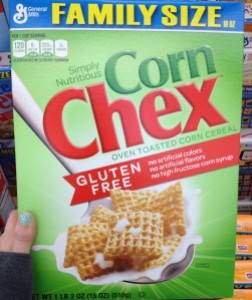If you’ve ever had the thrilling opportunity to accompany me to the grocery store, you have probably seen me randomly stop in the middle of a packed grocery aisle and exclaim, “SERIOUSLY?!”, causing the few people immediately surrounding us to stop and stare. I’m usually yelling at the product sporting a label in bright, bold colors that advertises it’s lack of a certain product (for example, gluten, which seems to be on EVERYTHING lately).
Lately, gluten-free diets have been THE diet to go with for whatever ails you, even going so far as a supposed cure for tiredness (have you tried sleeping?) and lack of energy (maybe incorporating some fruits and vegetables into your diet would help?). There have been lots of articles circulating on social media the last few weeks that discuss whether people who are “gluten-free” even understand what gluten really is. In case you’re wondering, gluten is derived from the Latin term for glue and is sort of like a food glue. Gluten is primarly found in wheat, although it is also in related plant species such as barley and rye. It’s the protein that gives us soft, airy, and chewy bread by giving dough the elasticity it needs to keep its shape and be delectably chewy, as well as the ability to rise and be soft instead of flat and tough.
However, there are people who cannot consume gluten without becoming incredibly ill. These people likely have something called Celiac’s disease, which affects approximately 1% of people in the world. Celiac’s is hereditary, which means that if someone in your immediate family has it, you have a chance of having it as well. People that have this are totally normal, except for the fact that they do their best to avoid gluten at all costs. If they consume just a small amount of gluten, their body’s immune system will attack the protein and can harm organs in their digestive system.
The thing that irritates me most about the whole “gluten-free” fad is that people automatically assume that gluten is what is bothering them rather than actually scheduling a doctor’s appointment. True, you may feel healthier by cutting out gluten, but you may be cutting out foods that aren’t neccesarily healthy for you and substituting them with fruits and vegetables. Sometimes, a healthier diet is enough to make whatever ails you go away, such as tiredness (which a good nap or earlier bedtime could cure) or lack of energy (which happens when you consume lots of simple sugars in junk food and pop that give you an immediate boost of energy, rather than complex carbohydrates which give you lasting energy).
There is also the theory out there that GMOs cause all sorts of food allergies, especially since food allergies and intolerances seem to be more frequently diagnosed in the last decade. Something to consider with this increase is accuracy in diagnosis or over-diagnosing (which I’m not completely doubting), as well as the increase in population over the years. It is also likely that people may have had an allergy to a food (peanuts, for example), but never encountered that food in their lifetime, especially up to the last hundred or two hundred years. Also, people used to die of “natural causes” before medicine has become as advanced as it is today. So that natural cause could have been an allergic reaction to food, also explaining the high death rate among infants and children. This could go for a number of things as well, maybe even including cancer, which also seems to be much more prevalent today. In the end, we should be thankful that we live in a time with advanced medical technology that has a high success rate of diagnosing and treat our illnesses.
While gluten-free diets are a necessity for some, the food industry has jumped on the gluten-free bandwagon. Check out this advertisement I found yesterday on a box of Corn Chex cereal. Corn does not contain gluten. So why advertise that this food is gluten-free? I understand that it could have been processed with trace amounts of gluten-containing flour or in the same facility. But the same thing happens often with peanuts and tree nuts. The only label those get is an 8-point font line underneath the ingredients list on the back of the package that says “May contain…, Contains…., or Was Processed In A Facility That Also Processes….”. Peanut allergies are just as severe as gluten intolerance, both of which can be life-threatening and require strict diets to avoid the problem foods. Why should gluten-free be advertised differently?
Honestly, this is an example of the food industry responding to the consumer. You vote with your food dollars. Whether this particular example is a good thing or a bad thing, it’s a great example nonetheless. So think about your food choices next time you’re at the grocery store.
How are you voting with your food dollars?


1 Comment
Jodi
May 17, 2014 at 7:50 pmMy husband makes loud exclamations at the store too lol